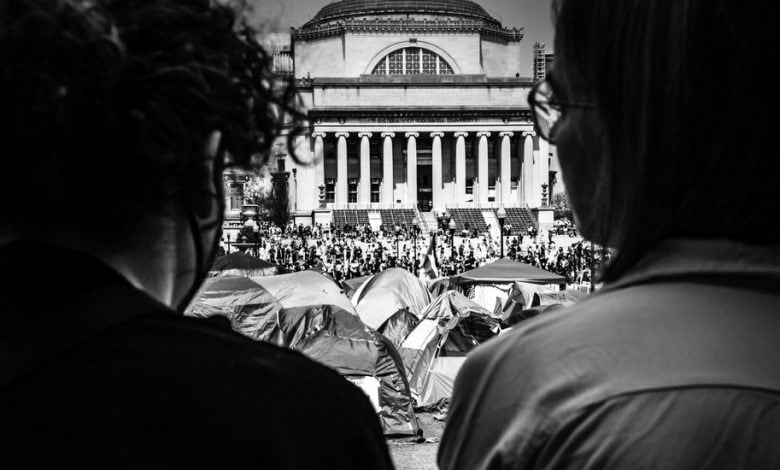The Battle Over College Speech Will Outlive the Encampments

Early on the afternoon of Nov. 10, Jameel Jaffer, the director of the Knight First Amendment Institute at Columbia University, was on his way into a meeting in Low Library, the domed neoclassical building at the center of campus, when an administrator pulled him aside. The school, the administrator said, was about to announce the suspensions of the campus chapters of the organizations Students for Justice in Palestine and Jewish Voice for Peace, an allied anti-Zionist organization — a move that alarmed Jaffer given the fraught politics of the moment.
Listen to this article, read by Gabra Zackman
The day after Hamas’s brazen Oct. 7 attack on military and civilian targets in Israel, the S.J.P. and J.V.P. chapters co-signed an open letter declaring “full solidarity with Palestinian resistance.” The letter described the attacks as “an unprecedented historic moment for the Palestinians of Gaza” and a “counteroffensive against their settler-colonial oppressor.” It would be tantamount to “asking for quiet submission to systemic violence” for anyone to call for peace now, after years of Israeli violence and military campaigns against Palestinians. The groups issued a list of demands to the university — divestment from companies doing business with the Israeli government, the end of Columbia’s affiliation with Tel Aviv University and a recognition of Palestinian “existence and humanity” — and announced a demonstration on Oct. 12 on the steps of Low Library. They signed off: “See you Thursday.”
The Oct. 12 demonstration appeared to be in violation of campus rules, which required student groups to give 10 days’ notice for gatherings in public spaces, but Columbia had not been enforcing such requirements amid the emotional responses to the Hamas attacks and Israel’s retaliatory bombing in the Gaza Strip. “We got some pushback from the university,” recalled Cameron Jones, an organizer of the J.V.P. chapter, “but not insane pushback.”
As the sit-ins, teach-ins and die-ins continued, however, that began to change. Pro-Israel groups held counterdemonstrations, and tensions built on Columbia’s small, enclosed central campus. “In the past, demonstrations were basically students protesting against the establishment, and that was, you know, unidirectional and fairly straightforward,” the president of Columbia, Minouche Shafik, said in late May, in her first interview since December. “In this crisis,” she went on, “students are opposed to other students, faculty opposed to other faculty. And those internal dynamics and tensions have made this much more difficult than past episodes.” Outside Columbia’s library, several Israeli students were physically attacked after they confronted another student tearing down posters of Israelis held hostage by Hamas. Students wearing hijabs and kaffiyehs reported being called “Jew killers” and terrorists.
By Oct. 25, when S.J.P. and J.V.P. staged a walkout of college classes, “our relationship with the administration was really crumbling,” Jones recalled. Two days later, Israel’s invasion of Gaza began. On the night of Nov. 8, with another demonstration planned for the next day on the steps outside Low, a faculty adviser told the organizers that they were out of compliance with school rules and asked them to postpone the event. They did not, and the university suspended them.